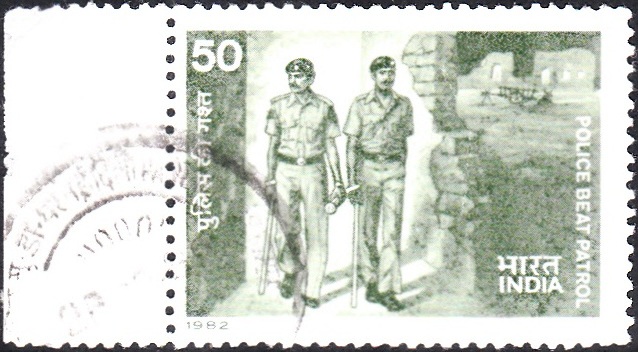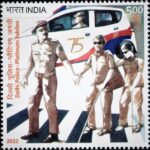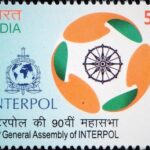
Police Beat Patrol
A commemorative postage stamp on Police Day : Beat, territory and time of police patrolling :
Issued on Oct 21, 1982
Issued for : Indian Posts & Telegraphs Department is happy to issue a stamp on the occasion of Police Commemoration Day.
Description of Designs : The stamp depicts the fundamental police activity, namely, patrolling the civilian areas night and day, in cities and villages, so that crimes may not occur, and the lurking criminal is caught. It is based on a design Brahm Prakash. The first day cover which has been designed by S. Kitson, is based on the Shanti Parva of the Mahabharata on ideal criminal administration. The cancellation, designed by Gautam Kaul, shows the integration of the public with the Police which is their motto.
Type : Stamp, Postal Used
Colour : Olive Green
Denomination : 50 Paise
Overall size : 3.91 X 2.90 cms.
Printing size : 3.55 X 2.54 cms.
Perforation : 13 x 13
Paper : Unwatermarked P. G. Matt coated stamp paper
Number printed : 20,00,000
Number per issue sheet : 35
Printing process : Photogravure
Printed at : India Security Press
About :
- The concept of organised Police activity in India is of recent origin although we do find some references to an incipient police technology operating in ancient India. The term “Police” is now used to denote a body of people organised to maintain civil order and to investigate breaches of the law. The police function is universal in society though it is only in the larger and more complex society of modern times that full time officials are appointed with special police responsibility, regulated by law.
- In ancient India amongst the first descriptions of a police activity, we find a reference in the epic Ramayana. Hanuman was sent by Lord Rama to the city of Lanka for reconnaissance. On returning from Lanka, (Sundara Kanda IV : 16) Hanuman described to Lord Rama, among other things, the opulence of the city and referred to a system of patrolling of the streets of Lanka by persons carrying sticks “Dandayudhadharas”. These persons undertook the duties of keeping the street clear of unwanted traffic.
- When the Mughals came to India to rule, they organised the ‘Kotwal‘ system. Earlier the ancient text of Kautilya‘s “Arthasastra” advised the king to develop an efficient system of espionage as an instrument of administration. This was also a kind of police activity.
- The system of policing as we know it today was first brought into force in India by the East India Company after the uprising of 1857 when it was realised that the territories governed by the East India Company and thereafter by the Government in England, required an efficient system of jurisprudence and a machinery to enforce the law. In 1860 the House of Commons in England passed the Indian Police Act, 1861 and at the same time enacted the Indian Penal Code. The Indian police system was established on the basis of the acts promulgated in India in the 1860’s as mentioned above.
- The police today are the primary civil agency in the welfare state to serve the people in protecting their life and property. Various state agencies have been set up to achieve these social objectives. The policeman guards the international borders as an aid to the Defence Forces, patrols the seas and the rivers, and in the performance of its duties resorts to such exotic devices as sending messages by using pigeons as couriers in the jungles of Orissa.
- Every year a large number of policemen lay down their lives in the course of their duties. Since 1947 more than 27,000 policemen have already made the supreme sacrifice to ensure social peace and stability.
- Every year on the 21st of October, the Nation’s Police Force remembers its martyrs, who laid down their lives to secure the society from the depredation of criminals. It was on the 21st October, 1960 that a police party patrolling the Himalayan heights in Ladakh was ambushed by a Chinese Military group in which 26 policemen were killed. The police party was patrolling territories well within the international border. This day is remembered as the Commemoration Day when police parades are organised in all the states, and homage is paid to those who laid down their lives while performing duty.
- Text : Gautam Kaul, Bureau of Police Research and Development.







